The Economics and Statistics Division maintains archives of previous publications for accountability purposes, but makes no updates to keep these documents current with the latest data revisions from Statistics Canada. As a result, information in older documents may not be accurate. Please exercise caution when referring to older documents. For the latest information and historical data, please contact the individual listed to the right.
<--- Return to Archive
For additional information relating to this article, please contact:
December 21, 2022NOVA SCOTIA QUARTERLY POPULATION ESTIMATES AS OF OCTOBER 1, 2022 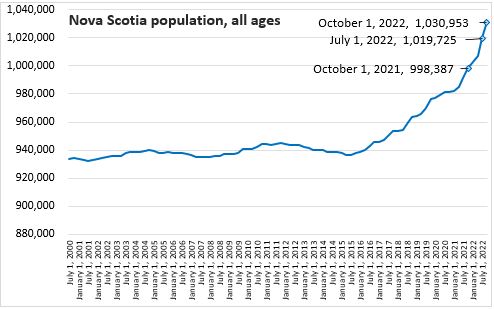
Nova Scotia's population was 1,030,953 as of October 1, 2022. This continues Nova Scotia's accelerated population growth - rising by 11,228 (+1.10%) from July 1, 2022. This is the second largest population increase for any quarter in the quarterly data going back to 1971.
Compared with October 1, 2021, Nova Scotia's population increased by 32,566 (+3.26%).
Since ending a period of population decline on April 1, 2015 Nova Scotia's population has increased by 94,682.
Nova Scotia's population growth this quarter reflected immigration, rising in-migration from other provinces, and large gain in net non-permanent residents. Natural population change (births less deaths) continues to draw Nova Scotia's population down.
There are seasonal patterns in quarterly population changes, particularly evident in births and migration. From July 1 to September 30, 2022, Nova Scotia posted a second consecutive population increase that is almost doubled any other Q2 period in the previous years.
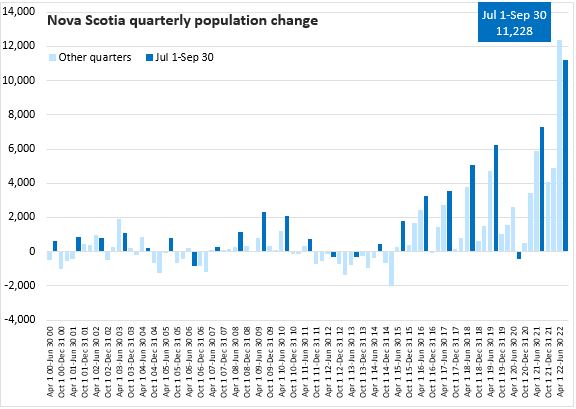
From July 1, 2022 to September 30, 2022 Nova Scotia’s population increased 1.10%, while the national population grew 0.93%. Nova Scotia had the third fastest population growth in the quarter among the provinces after Alberta and Prince Edward Island.
Compared with October 1, 2021 Nova Scotia’s population increased 3.26%, while the national population grew by 2.25%. Nova Scotia's population growth over this period was the second fastest among the provinces. Prince Edward Island (+3.77%) had the fastest growth over past year while the slowest was in Newfoundland and Labrador (+1.33%).
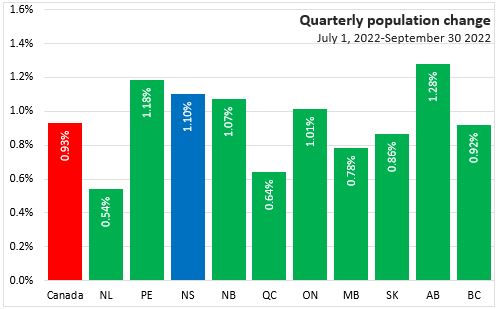
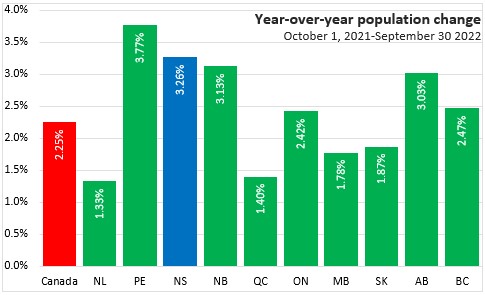
Immigration from other countries has been a strong contributor to population growth in Nova Scotia in recent years. While immigration slowed during periods of border restrictions over the course of the COVID-19 pandemic, there was a strong resurgence of immigration since July 1, 2021. Immigration to the province was 3,928 in the period from July 1 to September 30. This is the second largest increase in immigration for a quarter, after only Q4 2021, since 1946.

The net change in non-permanent residents in the province was an inflow of 5,378 from July 1 to September 30. This was a larger increase from net non-permanent residents than has been observed in any recent quarter.
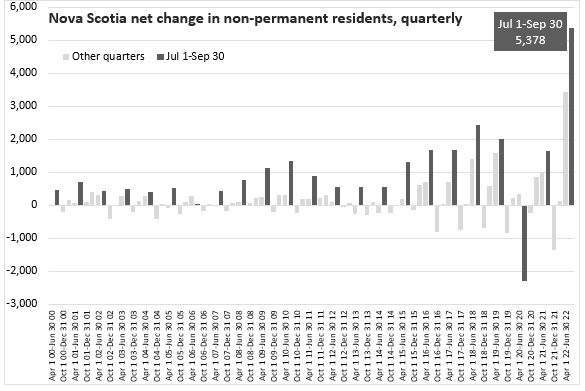
Nova Scotia’s natural population change (the number of births less the number of deaths) has been negative for several years. Between July 1 and September 30 there were 2,216 births and 2,558 deaths, amounting to an natural population decline of 342.
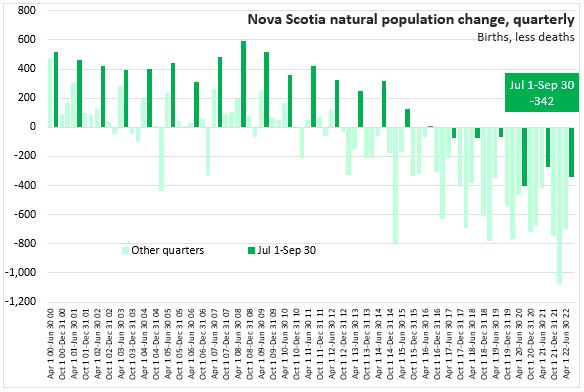
A total of 7,103 new Nova Scotians arrived in the province from other parts of Canada from July 1 to September 30. In-migration in the third quarter in 2022 was larger than the same period in previous years.
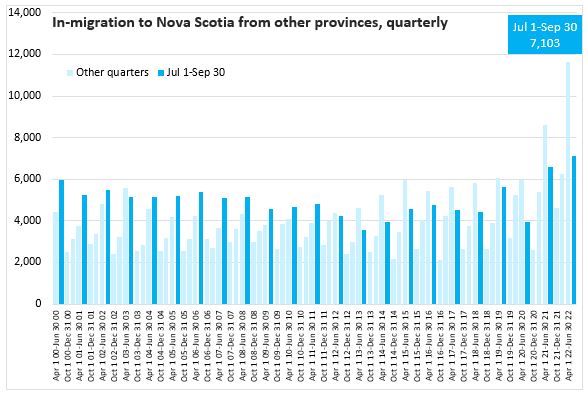
A total of 4,805 Nova Scotians left the province bound for other parts of Canada from July 1 to September 30.
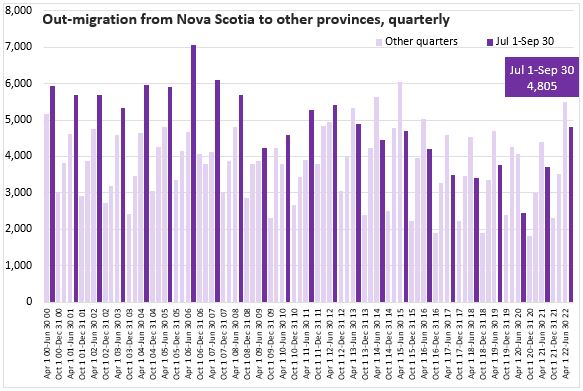
The net change in Nova Scotia's population from interprovincial migration was a gain of 2,298 from July 1 to September 30. A significant decline from the 6,159 during the Q2 2022. From October 1, 2021 to September 1, 2022 there were 13,521 more in-migrants to Nova Scotia than out-migrants.

The number of in-migrants to Nova Scotia from July 1 to September 30, 2022 increased by 528 from the same period in 2021. There were notable increases in in-migrants from Ontario with 4,156 in-migrants in the July 1 to September 30, 2022.
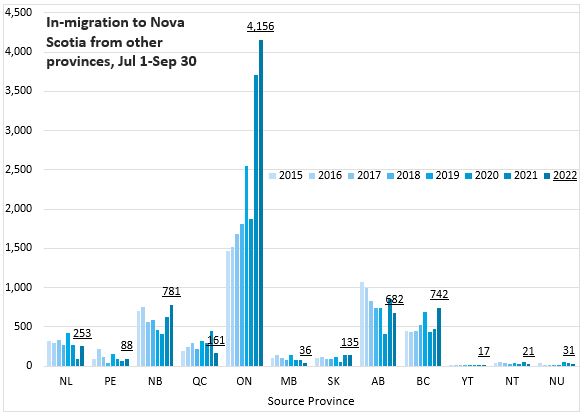
Out-migration from Nova Scotia to other provinces increased by 1,086 for July 1 to September 30 compared with the same period in 2021. Out-migration increased the most to Ontario and Alberta.
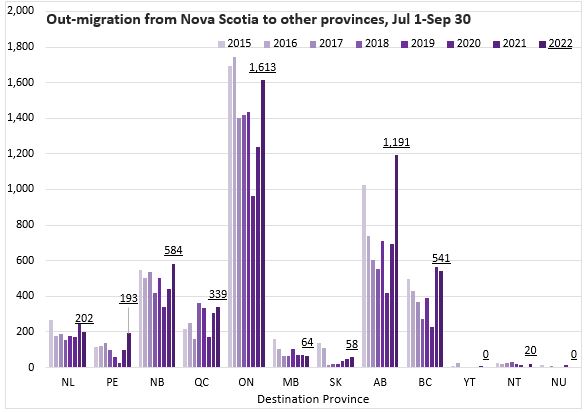
Comparing net interprovincial migration from July 1 to September 30, 2022 with the same period last year, overall net migration decreased by 558. The largest increases in net migration were from Ontario, British Columbia and New Brunswick.
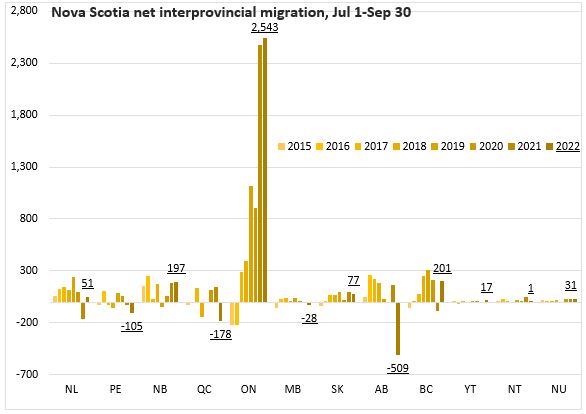
Source: Statistics Canada. Table 17-10-0009-01 Population estimates, quarterly; Table 17-10-0020-01 Estimates of the components of interprovincial migration, quarterly; Table 17-10-0040-01 Estimates of the components of international migration, quarterly; Table 17-10-0045-01 Estimates of interprovincial migrants by province or territory of origin and destination, quarterly; Table 17-10-0059-01 Estimates of the components of natural increase, quarterly
<--- Return to Archive